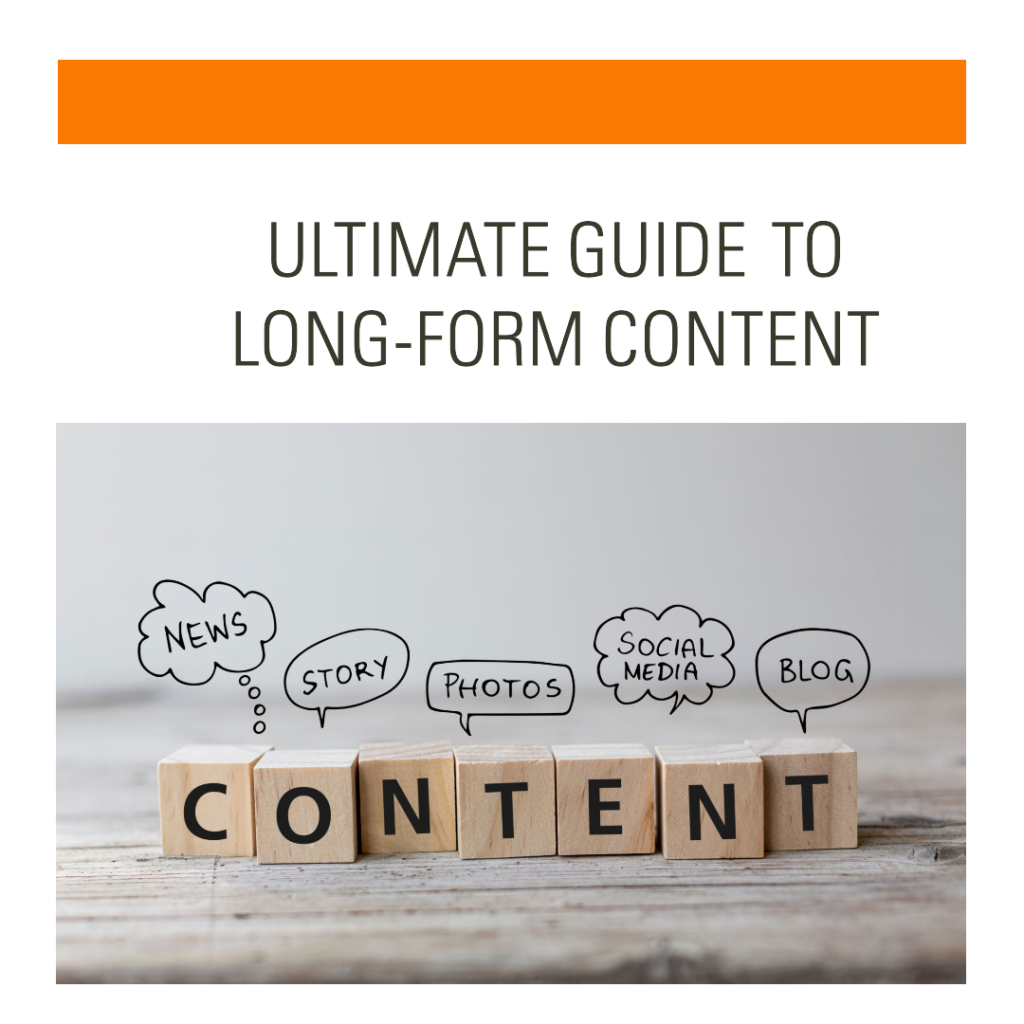Long-form content allows creators to go deeply into a topic, offering thorough explanations, analysis, and often includes research, examples, and citations.

Introduction
This guide to long-form content explains why it matters, and how to create appealing pieces that delight your readers and elevate your online presence.
Long form content is usually used to provide valuable insights, educate audiences, or explore complex subjects in depth.
What is Long-Form Content?
Long-form content refers to articles, blog posts, or any written material that goes into depth on a particular topic.
It can be any piece of content, typically written but can also include video or audio, that is in-depth, detailed, and comprehensive. It’s characterised by its length, usually spanning over 1,000 words for written content, though there’s no strict rule regarding its length.
Benefits of Long-Form Content

Long-form content has several benefits, especially in the realm of online content creation and marketing:
- Comprehensive Coverage: Long-form content allows for a thorough exploration of a topic, leaving no stone unturned.
- Higher Engagement: Readers tend to spend more time enchanting with long-form content, leading to lower bounce rates.
- Increased Authority: In-depth articles showcase expertise and authority in a particular field or niche.
- SEO: Search engines often favour longer, informative content, potentially boosting your website’s visibility.
- Better Shareability: Well-researched and informative long-form pieces are more likely to be shared on social media platforms, expanding your reach.
- Authority Building: Demonstrating expertise in your field through detailed content establishes your website as a go-to resource for information.
- Conversion Potential: Long-form content can nurture leads and guide them through the buyer’s journey, increasing conversion rates.
Characteristics of Long-Form Content
The content needs to be comprehensive, in-depth, and usually longer than traditional content formats like blog posts or articles. Here are some key characteristics of long-form content:
- Word Count: Typically, long-form content exceeds 1,000 words, with some pieces stretching into several thousand words.
- Research-Driven: Long-form content relies on thorough research, including data, statistics, and expert opinions.
- Structured Format: It often includes clear headings, subheadings, and sections to guide readers through the material.
- Visual Elements: Incorporating images, infographics, or videos can enhance the readability and appeal of long-form content.
Research and Topic Selection for Long-Form Content

When it comes to creating long-form content, audience, topics and research are the key things to have in mind. There are several key steps to ensure your content is engaging, informative, and well-structured.
Understand Your Audience
- Identify Your Target Audience: Determine who your content is intended for, their interests, needs, and pain points.
- Conduct Audience Research: Use tools like Google Analytics, social media insights, or surveys to gather information about your audience’s preferences and behaviour.
Brainstorm Topics
- Keyword Research: Use tools like Google Keyword Planner or SEMrush to discover popular search terms and topics relevant to your niche.
- Mind Mapping: Create a mind map to brainstorm potential topics related to your audience’s interests and your expertise.
- Check Trends: Stay updated on current trends and discussions in your industry to identify timely and relevant topics.
Evaluate Topic Viability
- Relevance: Make sure that the topic aligns with your audience’s interests and addresses their needs or concerns.
- Search Volume: Choose topics with a decent search volume to ensure there’s enough interest and potential traffic.
- Competition: Assess the level of competition for your chosen topic and consider your ability to offer a unique perspective or value.
Conduct In-Depth Research
- Primary Sources: Gather information from reliable sources such as academic journals, industry reports, and interviews with experts.
- Secondary Sources: Use online resources like articles, blog posts, and reputable websites to gather additional insights.
- Take Notes: Organise your research findings and key points to facilitate easier referencing during the content creation process.
Narrow Down Your Topic
- Focus on Specific Angle: Choose a unique angle or aspect of the topic to explore in-depth, rather than covering too broad of a subject.
- Address a Gap: Identify areas within the topic that haven’t been extensively covered and aim to provide valuable insights or solutions.
Outline Your Content
- Create a Structure: Develop an outline that outlines the main sections and subtopics of your content, pledging a logical flow of information.
- Include Keywords: Involve relevant keywords naturally throughout your outline for search engines and improve discoverability.
Review and Refine
- Peer Feedback: Seek input from colleagues, friends, or industry peers to get fresh perspectives on your chosen topic and content outline.
- Iterate: Refine your topic selection and content outline based on feedback received, securing clarity, relevance, and value.
Create a Definitive Title
- Keyword optimisation: Add your target keyword naturally into the title.
- Make it intriguing: Use words that spark curiosity or promise value to the reader.
- Keep it concise: Aim for a title that is both descriptive and concise, ideally under 70 characters for optimal search engine visibility.
Structuring Your Long Form Content

- Use headings and subheadings: Break your content into easily digestible sections with clear headings (H2 and H3) for better readability.
- Introduction: Hook your readers with a charming introduction that sets the tone and previews what they can expect from the content.
- Main body: Organise your points logically, providing valuable information, examples, and insights to support your topic.
- Conclusion: Summarise key points and provide a call to action, encouraging readers to engage further with your content.
Involving Visuals in Long-Form Content
- Images: Use high-quality images, infographics, or charts to enrich your content and break up text.
- Videos: Embed relevant videos to provide additional context or demonstration where applicable.
- Captions and Alt Text: Include descriptive captions and alt text for images to improve accessibility and SEO.
Writing Interesting Copy
- Use storytelling: Make narratives that delight your audience and evoke emotion.
- Be conversational: Write in a friendly and approachable tone, as if you’re having a conversation with your readers.
- Provide value: Offer actionable tips, insights, or solutions to address your audience’s pain points or interests.
Expanding for SEO
- On-page SEO: Well-optimised content for search engines by adding relevant keywords, meta tags, and internal links.
- Mobile friendliness: Make sure your content is responsive and accessible on all devices, as mobile upgrading is important for SEO.
- Page speed: Improve loading times by perfecting images, minimising code, and using caching plugins to intensify user experience and SEO performance.
Editing and Polishing Long-Form Content

Editing and polishing long-form content makes it appealing, error-free, and ready to please your audience. Let’s look at the steps for editing your content.
Step 1: Review for Structure and Flow
- SEO Keywords: content structure, flow, readability
- Begin by reviewing the overall structure of your content.
- Ensure that your content flows logically from one point to the next.
- Look for any areas where the flow might be disrupted or confusing.
- Make adjustments to improve the overall structure and flow of your content.
Step 2: Check for Clarity and Consistency
- SEO Keywords: clarity, consistency, readability
- Read through your content carefully to ensure it is clear and easy to understand.
- Look for any sentences or phrases that might be unclear or confusing to your audience.
- Check for consistency in tone, style, and formatting throughout your content.
- Make any necessary revisions to improve clarity and maintain consistency.
Step 3: Polish for Grammar and Spelling in Long Form Content
- SEO Keywords: grammar, spelling, proofreading
- Carefully proofread your content for grammar and spelling errors.
- Look for common mistakes such as typos, punctuation errors, and grammatical inconsistencies.
- Consider using grammar-checking tools or enlisting the help of a proofreader to catch any errors you might have missed.
- Make corrections as needed to ensure your content is polished and error-free.
Step 4: Strengthen Long Form Content with Visuals and Multimedia
- SEO Keywords: visuals, multimedia, engagement
- Consider combining visuals such as images, infographics, or videos to enhance your content.
- Visuals can help break up large blocks of text and make your content more visually appealing.
- Be sure to choose visuals that are relevant to your content and enrich the overall message you are trying to convey.
- Embodying multimedia elements can also help increase engagement with your audience.
Step 5: Get Feedback and Iterate
- SEO Keywords: feedback, iteration, improvement
- Once you’ve completed your edits, consider seeking feedback from others.
- Ask colleagues, friends, or trusted advisors to review your content and provide constructive criticism.
- Use this feedback to identify areas for improvement and make any necessary revisions.
- Continue iterating on your content until you are satisfied with the final result.
Promoting and Distributing Long-Form Content

Long-form content can be incredibly valuable for engaging your audience and driving traffic to your website. Here is how to do it:
Use Social Media Platforms
- Share on social media: Post snippets or highlights of your long-form content on platforms like Facebook, Twitter, Instagram, and LinkedIn. Use catchy captions and relevant hashtags to increase visibility.
- Engage with your Audience: Respond to comments and messages related to your content. Encourage discussions and interactions to boost engagement and reach.
Email Marketing Campaigns
- Segment your Email List: Send targeted emails to specific segments of your audience who are likely to be interested in your long-form content.
- Create Compelling Subject Lines: Grab attention with intriguing subject lines that entice recipients to open your emails and read the content.
Collaborate with Influencers
- Identify Relevant Influencers: Find influencers in your niche whose audience aligns with your target audience.
- Leverage Influencer Reach: Collaborate with influencers to share your long-form content with their followers, expanding your reach significantly.
Search Engine Optimisation (SEO)
- Keyword Research: Identify relevant keywords related to your long-form content and combine them naturally throughout your website and content.
- Optimise Meta Tags: Write compelling Meta titles and descriptions that include relevant keywords to improve search engine visibility.
Guest Posting and Cross-Promotion
- Write Guest Posts: Contribute long-form content to reputable websites or blogs in your industry. Include a link back to your content for increased traffic.
- Cross-Promote with Partners: Collaborate with other businesses or organisations to promote each other’s long-form content, reaching new audiences.
Repurpose Content
- Create Visual Assets: Turn primary points from your long-form content into infographics, videos, or slideshows for sharing on social media and other platforms.
- Create Podcast Episodes: Convert your long-form content into podcast episodes, reaching audiences who prefer audio content.
Enwrap with Long Form Content Online Communities
- Join Relevant Forums and Groups: Participate in discussions and share your long-form content when relevant but avoid spamming.
- Provide Value: Offer valuable insights and solutions to problems within online communities, establishing yourself as an authority in your niche.
Conclusion
Long-form content is a powerful tool for attracting your audience, establishing authority, and improving your search engine rankings. However, it’s essential to balance length with quality; long-form content should provide genuine value to your audience to be truly effective.
In essence, long-form content serves as a cornerstone of your website’s content plan, driving organic traffic, engaging visitors, and establishing your brand as a trusted authority in your industry.
We hope this article helped you learn about Long-Form Content. You may also want to see our guide on how to create a content style guide for your business .
If you liked this article, then please subscribe to our YouTube Channel for video tutorials and more. You can also find us on LinkedIn, Twitter and Pinterest.




